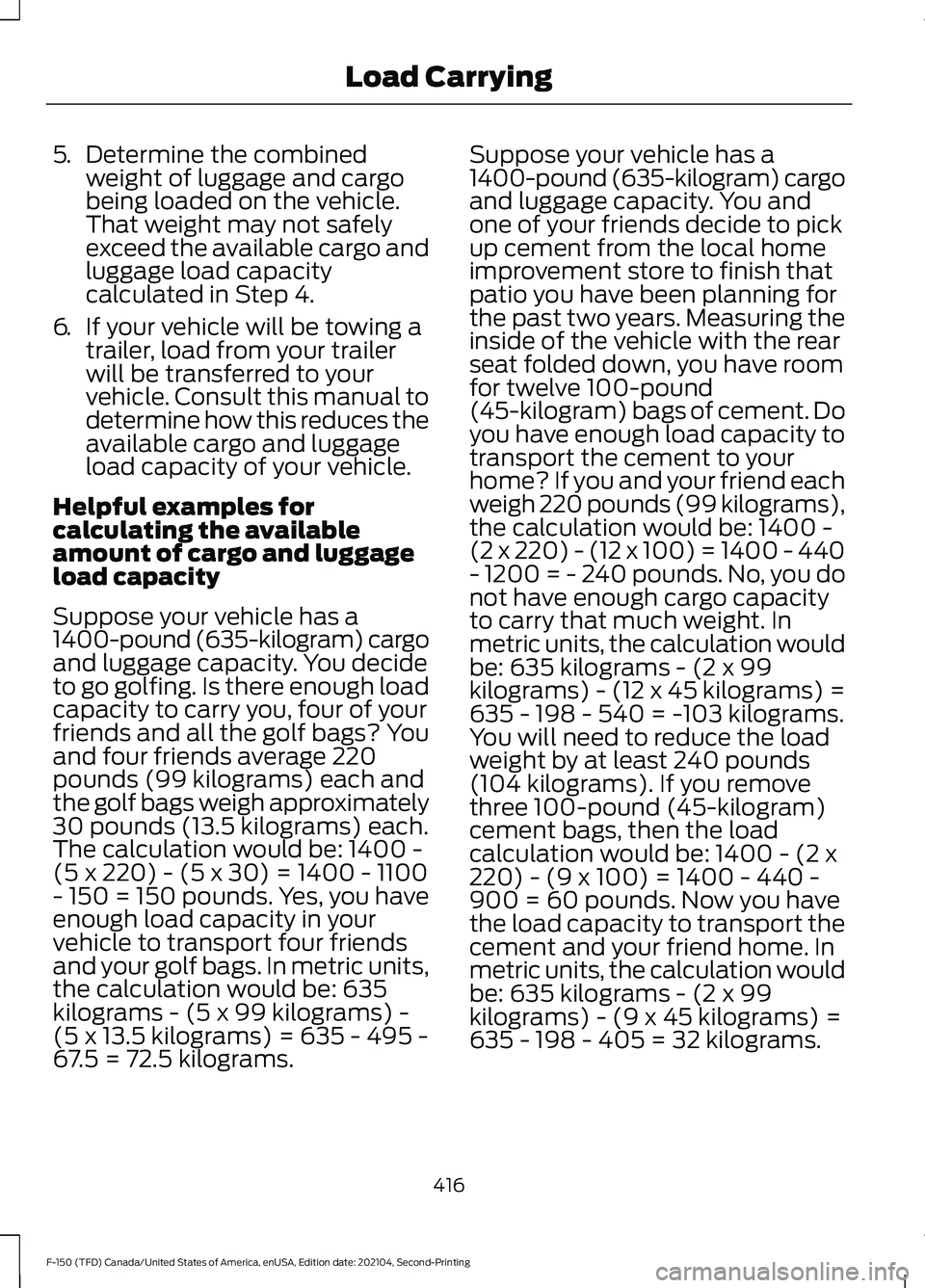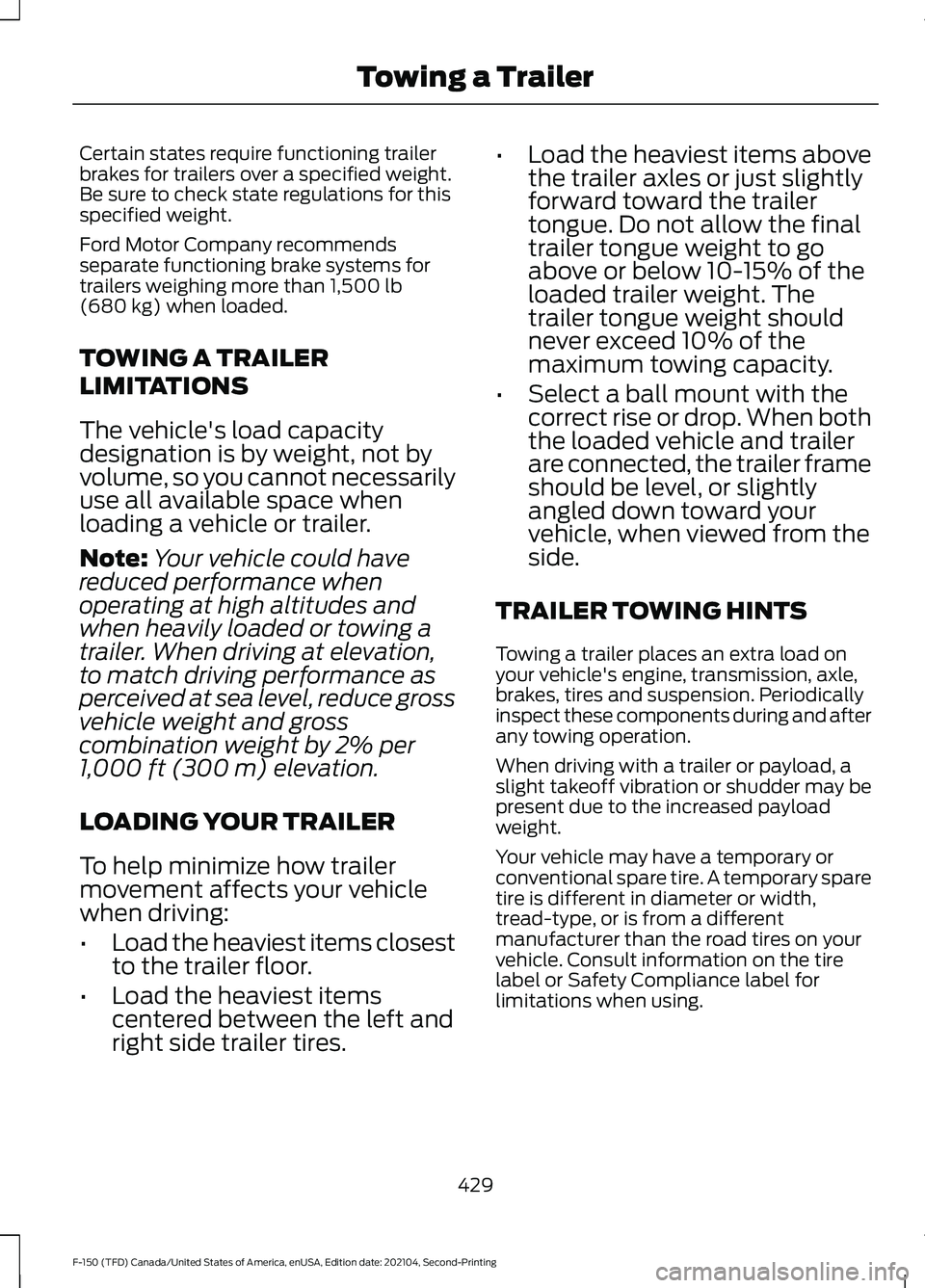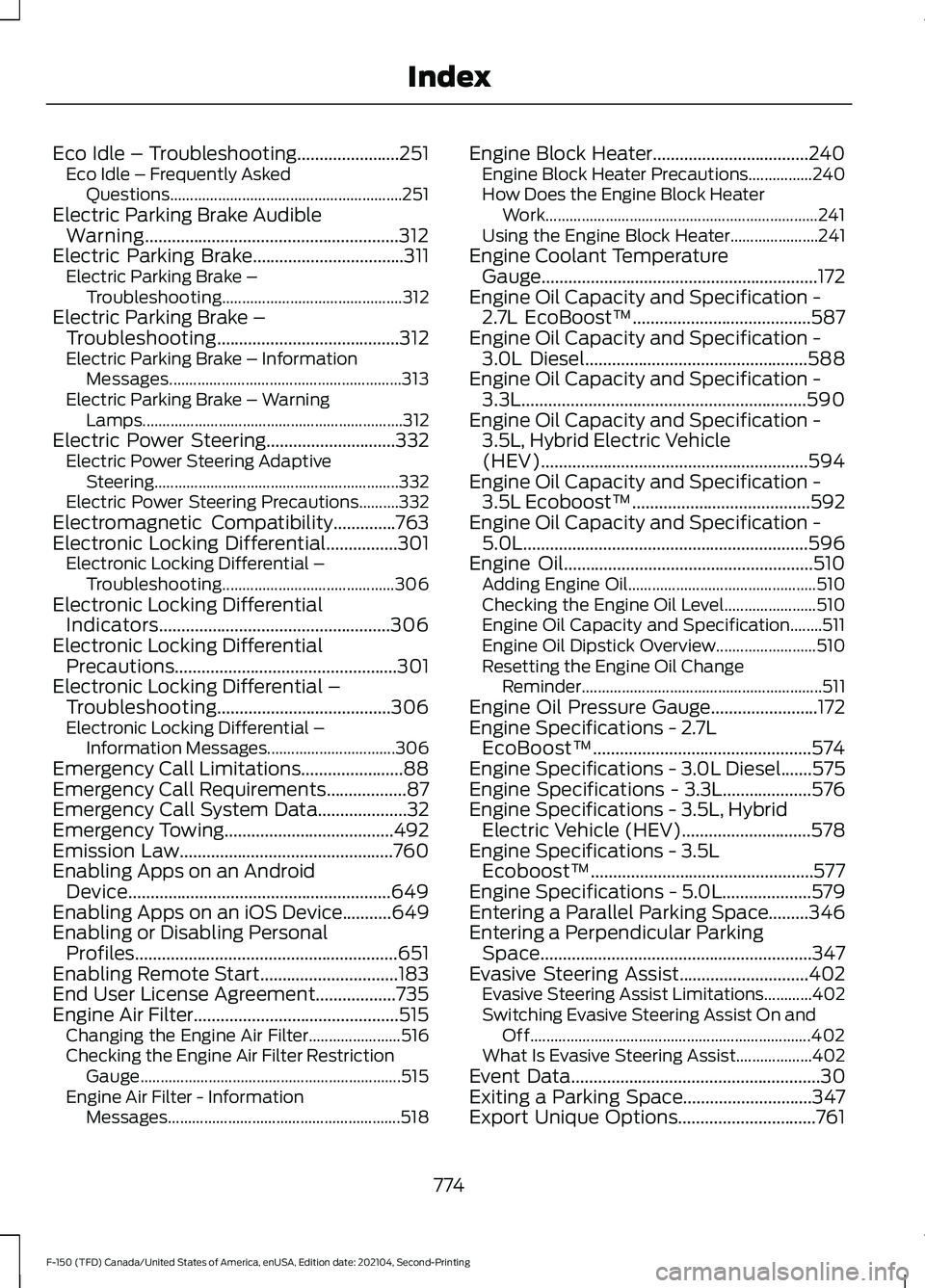towing capacity FORD F-150 2021 Owners Manual
[x] Cancel search | Manufacturer: FORD, Model Year: 2021, Model line: F-150, Model: FORD F-150 2021Pages: 796, PDF Size: 13.89 MB
Page 419 of 796

CALCULATING PAYLOAD
Tire and Loading Label Information
Example:
Payload is the combined weight
of cargo and passengers that your
vehicle is carrying. The maximum
payload for your vehicle appears
on the Tire and Loading label. The
label is either on the B-pillar or the
edge of the driver door. Vehicles
exported outside the US and
Canada may not have a tire and
loading label. Look for
“The
combined weight of occupants
and cargo should never exceed
XXX kg or XXX lb ” for maximum
payload. The payload listed on the
Tire and Loading Information label is the maximum payload for your
vehicle as built by the assembly
plant. If you install any additional
equipment on your vehicle, you
must determine the new payload.
Subtract the weight of the
equipment from the payload listed
on the Tire and Loading label.
When towing, trailer tongue
weight or king pin weight is also
part of payload.
CALCULATING THE LOAD
LIMIT
Steps for determining the correct
load limit:
1. Locate the statement "The
combined weight of occupants
and cargo should never exceed
XXX kg or XXX lb." on your
vehicle ’s placard.
2. Determine the combined
weight of the driver and
passengers that will be riding
in your vehicle.
3. Subtract the combined weight
of the driver and passengers
from XXX kg or XXX lb.
4. The resulting figure equals the
available amount of cargo and
luggage load capacity. For
example, if the “XXX” amount
equals 1,400 lb. and there will
be five 150 lb. passengers in
your vehicle, the amount of
available cargo and luggage
load capacity is 650 lb.
(1400-750 (5 x 150) = 650 lb.)
415
F-150 (TFD) Canada/United States of America, enUSA, Edition date: 202104, Second-Printing Load CarryingE198719
Page 420 of 796

5.
Determine the combined
weight of luggage and cargo
being loaded on the vehicle.
That weight may not safely
exceed the available cargo and
luggage load capacity
calculated in Step 4.
6. If your vehicle will be towing a
trailer, load from your trailer
will be transferred to your
vehicle. Consult this manual to
determine how this reduces the
available cargo and luggage
load capacity of your vehicle.
Helpful examples for
calculating the available
amount of cargo and luggage
load capacity
Suppose your vehicle has a
1400-pound (635-kilogram) cargo
and luggage capacity. You decide
to go golfing. Is there enough load
capacity to carry you, four of your
friends and all the golf bags? You
and four friends average 220
pounds (99 kilograms) each and
the golf bags weigh approximately
30 pounds (13.5 kilograms) each.
The calculation would be: 1400 -
(5 x 220) - (5 x 30) = 1400 - 1100
- 150 = 150 pounds. Yes, you have
enough load capacity in your
vehicle to transport four friends
and your golf bags. In metric units,
the calculation would be: 635
kilograms - (5 x 99 kilograms) -
(5 x 13.5 kilograms) = 635 - 495 -
67.5 = 72.5 kilograms. Suppose your vehicle has a
1400-pound (635-kilogram) cargo
and luggage capacity. You and
one of your friends decide to pick
up cement from the local home
improvement store to finish that
patio you have been planning for
the past two years. Measuring the
inside of the vehicle with the rear
seat folded down, you have room
for twelve 100-pound
(45-kilogram) bags of cement. Do
you have enough load capacity to
transport the cement to your
home? If you and your friend each
weigh 220 pounds (99 kilograms),
the calculation would be: 1400 -
(2 x 220) - (12 x 100) = 1400 - 440
- 1200 = - 240 pounds. No, you do
not have enough cargo capacity
to carry that much weight. In
metric units, the calculation would
be: 635 kilograms - (2 x 99
kilograms) - (12 x 45 kilograms) =
635 - 198 - 540 = -103 kilograms.
You will need to reduce the load
weight by at least 240 pounds
(104 kilograms). If you remove
three 100-pound (45-kilogram)
cement bags, then the load
calculation would be: 1400 - (2 x
220) - (9 x 100) = 1400 - 440 -
900 = 60 pounds. Now you have
the load capacity to transport the
cement and your friend home. In
metric units, the calculation would
be: 635 kilograms - (2 x 99
kilograms) - (9 x 45 kilograms) =
635 - 198 - 405 = 32 kilograms.
416
F-150 (TFD) Canada/United States of America, enUSA, Edition date: 202104, Second-Printing Load Carrying
Page 422 of 796

PICKUP BED PRECAUTIONS
WARNING: Do not allow people or
animals in truck beds that have
modifications, such as bed covers or
slide-in campers, when the engine is
running. Exhaust fumes are toxic. Failure
to follow this instruction could result in
personal injury or death. WARNING: It is extremely
dangerous to ride in a cargo area, inside
or outside of a vehicle. In a crash, people
riding in these areas are more likely to be
seriously injured or killed. Do not allow
people to ride in any area of your vehicle
that is not equipped with seats and
seatbelts. Make sure everyone in your
vehicle is in a seat and properly using a
seatbelt. Failure to follow this warning
could result in serious personal injury or
death.
PICKUP BED ANCHOR POINTS
PICKUP BED ANCHOR POINT
PRECAUTIONS WARNING: Always properly secure
cargo to prevent shifting cargo or cargo
falling from the vehicle. Failure to do so
could result in compromised vehicle
stability and serious personal injury to
vehicle occupants or others. WARNING:
The appropriate
loading capacity of your vehicle can be
limited either by volume capacity (how
much space is available) or by payload
capacity (how much weight the vehicle
should carry). Once you have reached the maximum payload of your vehicle,
do not add more cargo, even if there is
space available. Overloading or
improperly loading your vehicle can
contribute to loss of vehicle control and
vehicle rollover.
WARNING:
It is extremely
dangerous to ride in a cargo area, inside
or outside of a vehicle. In a crash, people
riding in these areas are more likely to be
seriously injured or killed. Do not allow
people to ride in any area of your vehicle
that is not equipped with seats and
seatbelts. Make sure everyone in your
vehicle is in a seat and properly using a
seatbelt. Failure to follow this warning
could result in serious personal injury or
death. WARNING:
Do not use the load
retaining fixtures for towing. Failure to
follow this instruction could result in
personal injury. WARNING:
Do not exceed the
maximum load rating of the load
retaining fixtures. Failure to follow this
instruction could result in personal injury. WARNING:
Check the load
retaining fixtures for damage before
using them. Failure to follow this
instruction could result in personal injury.
LOCATING THE PICKUP BED
ANCHOR POINTS
The pickup bed anchor points are located
at each corner of the pickup bed.
418
F-150 (TFD) Canada/United States of America, enUSA, Edition date: 202104, Second-Printing Pickup Bed
Page 432 of 796

TOWING A TRAILER
PRECAUTIONS
WARNING: Do not exceed
the GVWR or the GAWR
specified on the certification
label. WARNING:
Towing trailers
beyond the maximum
recommended gross trailer
weight exceeds the limit of your
vehicle and could result in engine
damage, transmission damage,
structural damage, loss of
vehicle control, vehicle rollover
and personal injury. WARNING:
Do not exceed
the lowest rating capacity for
your vehicle or trailer hitch.
Overloading your vehicle or
trailer hitch can impair your
vehicle stability and handling.
Failure to follow this instruction
could result in the loss of control
of your vehicle, personal injury or
death. WARNING: Make sure that
the vertical load on the tow ball
is between the minimum and
maximum recommended weight
at all times. Failure to follow this
instruction could result in the
loss of control of your vehicle,
personal injury or death. WARNING:
Do not cut,
drill, weld or modify the trailer
hitch. Modifying the trailer hitch
could reduce the hitch rating. WARNING:
The anti-lock
brake system does not control
the trailer brakes.
TRAILER BRAKE
PRECAUTIONS WARNING:
Do not connect a
trailer's hydraulic brake system directly
to your vehicle's brake system. Your
vehicle may not have enough braking
power and your chances of having a
collision greatly increase. WARNING:
Do not tow a trailer
fitted with electric trailer brakes unless
your vehicle is fitted with a compatible
aftermarket electronic trailer brake
controller. Failure to follow this
instruction could result in the loss of
control of your vehicle, personal injury or
death. For additional information and
assistance, we recommend that you
contact an authorized dealer.
Electric brakes and manual, automatic or
surge-type trailer brakes are safe if you
install them properly and adjust them to
the manufacturer's specifications. The
trailer brakes must meet local and federal
regulations.
The rating for the tow vehicle's braking
system operation is at the gross vehicle
weight rating, not the gross combined
weight rating.
428
F-150 (TFD) Canada/United States of America, enUSA, Edition date: 202104, Second-Printing Towing a Trailer
Page 433 of 796

Certain states require functioning trailer
brakes for trailers over a specified weight.
Be sure to check state regulations for this
specified weight.
Ford Motor Company recommends
separate functioning brake systems for
trailers weighing more than 1,500 lb
(680 kg) when loaded.
TOWING A TRAILER
LIMITATIONS
The vehicle's load capacity
designation is by weight, not by
volume, so you cannot necessarily
use all available space when
loading a vehicle or trailer.
Note: Your vehicle could have
reduced performance when
operating at high altitudes and
when heavily loaded or towing a
trailer. When driving at elevation,
to match driving performance as
perceived at sea level, reduce gross
vehicle weight and gross
combination weight by 2% per
1,000 ft (300 m)
elevation.
LOADING YOUR TRAILER
To help minimize how trailer
movement affects your vehicle
when driving:
• Load the heaviest items closest
to the trailer floor.
• Load the heaviest items
centered between the left and
right side trailer tires. •
Load the heaviest items above
the trailer axles or just slightly
forward toward the trailer
tongue. Do not allow the final
trailer tongue weight to go
above or below 10-15% of the
loaded trailer weight. The
trailer tongue weight should
never exceed 10% of the
maximum towing capacity.
• Select a ball mount with the
correct rise or drop. When both
the loaded vehicle and trailer
are connected, the trailer frame
should be level, or slightly
angled down toward your
vehicle, when viewed from the
side.
TRAILER TOWING HINTS
Towing a trailer places an extra load on
your vehicle's engine, transmission, axle,
brakes, tires and suspension. Periodically
inspect these components during and after
any towing operation.
When driving with a trailer or payload, a
slight takeoff vibration or shudder may be
present due to the increased payload
weight.
Your vehicle may have a temporary or
conventional spare tire. A temporary spare
tire is different in diameter or width,
tread-type, or is from a different
manufacturer than the road tires on your
vehicle. Consult information on the tire
label or Safety Compliance label for
limitations when using.
429
F-150 (TFD) Canada/United States of America, enUSA, Edition date: 202104, Second-Printing Towing a Trailer
Page 776 of 796

Connecting Your Phone............................643
Contacting Us..................................................22
Cooling System Capacity and Specification - 2.7L EcoBoost™.........598
Cooling System Capacity and Specification - 3.0L Diesel....................599
Cooling System Capacity and Specification - 3.3L
..................................599
Cooling System Capacity and Specification - 3.5L, Hybrid Electric
Vehicle (HEV)
.............................................601
Cooling System Capacity and Specification - 3.5L Ecoboost™,
Raptor, Police Responder
.....................602
Cooling System Capacity and Specification - 3.5L Ecoboost™
........600
Cooling System Capacity and Specification - 5.0L
..................................601
Crash and Breakdown Information.................................................483
Automatic Crash Shutoff................................ 487
Jump Starting the Vehicle.............................. 485
Post-Crash Alert System................................ 487
Recovery Towing............................................... 488
Crash Sensors and Airbag Indicator........79
Crash Sensors and Airbag Indicator - Police Responder
........................................80
Creating a MyKey - Vehicles With: Flip Key..................................................................100
Creating a MyKey - Vehicles With: Push Button Start..................................................99
Creating a Personal Profile......................652
Creating a Vehicle Wi-Fi Hotspot..........624
Cross Traffic Alert........................................393 Cross Traffic Alert –
Troubleshooting............................................ 395
Cross Traffic Alert Indicators...................394
Cross Traffic Alert Limitations
................393
Cross Traffic Alert Precautions...............393
Cross Traffic Alert – Troubleshooting........................................395
Cross Traffic Alert – Information Messages......................................................... 395
Cruise Control...............................................350
Cruise Control Indicators...........................351
Cup Holders...................................................232 Cup Holder Precautions.................................. 232Customer Information
...............................683
Radio Frequency Certification
Labels................................................................ 705
Customizing the Instrument Cluster Display...........................................................180
D
Data Privacy
.....................................................29
Decommissioning Requirements..........682
Decommissioning the Vehicle................682
Department of Transportation Uniform Tire Quality Grades
..................................542
Deploying and Stowing the Power Running Boards..........................................139
Diesel Exhaust Fluid Capacity and Specification...............................................277
Diesel Exhaust Fluid Gauge
.......................172
Diesel Particulate Filter.............................268 Diesel Particulate Filter Manual
Regeneration.................................................. 269
Diesel Particulate Filter – Troubleshooting.............................................. 271
Diesel Particulate Filter Manual Regeneration..............................................269
Diesel Particulate Filter Manual Regeneration Limitations........................... 270
Diesel Particulate Filter Manual Regeneration Precautions......................... 269
Diesel Particulate Filter Manual Regeneration Requirements....................269
Starting Diesel Particulate Filter Manual Regeneration
.................................................. 270
What Is Diesel Particulate Filter Manual Regeneration.................................................. 269
Diesel Particulate Filter Precautions................................................268
Diesel Particulate Filter Requirements............................................269
Diesel Particulate Filter – Troubleshooting..........................................271
Diesel Particulate Filter – Information Messages........................................................... 271
Diesel Particulate Filter – Warning Lamps................................................................. 271
Digital Radio..................................................629 Digital Radio Indicators................................... 630
Digital Radio Limitations................................ 629
772
F-150 (TFD) Canada/United States of America, enUSA, Edition date: 202104, Second-Printing Index
Page 778 of 796

Eco Idle – Troubleshooting.......................251
Eco Idle – Frequently Asked
Questions.......................................................... 251
Electric Parking Brake Audible Warning.........................................................312
Electric Parking Brake..................................311
Electric Parking Brake –
Troubleshooting............................................. 312
Electric Parking Brake – Troubleshooting.........................................312
Electric Parking Brake – Information Messages.......................................................... 313
Electric Parking Brake – Warning Lamps................................................................. 312
Electric Power Steering.............................332 Electric Power Steering Adaptive
Steering............................................................. 332
Electric Power Steering Precautions..........332
Electromagnetic Compatibility
..............763
Electronic Locking Differential................301 Electronic Locking Differential –
Troubleshooting........................................... 306
Electronic Locking Differential Indicators....................................................306
Electronic Locking Differential Precautions..................................................301
Electronic Locking Differential – Troubleshooting.......................................306
Electronic Locking Differential – Information Messages................................ 306
Emergency Call Limitations.......................88
Emergency Call Requirements
..................87
Emergency Call System Data....................32
Emergency Towing
......................................492
Emission Law................................................760
Enabling Apps on an Android Device...........................................................649
Enabling Apps on an iOS Device...........649
Enabling or Disabling Personal Profiles...........................................................651
Enabling Remote Start...............................183
End User License Agreement..................735
Engine Air Filter..............................................515 Changing the Engine Air Filter....................... 516
Checking the Engine Air Filter Restriction Gauge................................................................. 515
Engine Air Filter - Information Messages.......................................................... 518Engine Block Heater...................................240
Engine Block Heater Precautions................240
How Does the Engine Block Heater
Work.................................................................... 241
Using the Engine Block Heater...................... 241
Engine Coolant Temperature Gauge..............................................................172
Engine Oil Capacity and Specification - 2.7L EcoBoost™
........................................587
Engine Oil Capacity and Specification - 3.0L Diesel
..................................................588
Engine Oil Capacity and Specification - 3.3L................................................................590
Engine Oil Capacity and Specification - 3.5L, Hybrid Electric Vehicle
(HEV)............................................................594
Engine Oil Capacity and Specification - 3.5L Ecoboost™........................................592
Engine Oil Capacity and Specification - 5.0L................................................................596
Engine Oil........................................................510 Adding Engine Oil............................................... 510
Checking the Engine Oil Level....................... 510
Engine Oil Capacity and Specification........511
Engine Oil Dipstick Overview......................... 510
Resetting the Engine Oil Change Reminder............................................................ 511
Engine Oil Pressure Gauge........................172
Engine Specifications - 2.7L EcoBoost™.................................................574
Engine Specifications - 3.0L Diesel.......575
Engine Specifications - 3.3L....................576
Engine Specifications - 3.5L, Hybrid Electric Vehicle (HEV)
.............................578
Engine Specifications - 3.5L Ecoboost™..................................................577
Engine Specifications - 5.0L....................579
Entering a Parallel Parking Space.........346
Entering a Perpendicular Parking Space.............................................................347
Evasive Steering Assist.............................402 Evasive Steering Assist Limitations............402
Switching Evasive Steering Assist On and
Off...................................................................... 402
What Is Evasive Steering Assist................... 402
Event Data
........................................................30
Exiting a Parking Space.............................347
Export Unique Options...............................761
774
F-150 (TFD) Canada/United States of America, enUSA, Edition date: 202104, Second-Printing Index